#kurzweil digital piano
Video
youtube
Kurzweil SP7 Grand - What's In The Box?
#youtube#kurzweil#sp7 grand#kurzweil sp7 grand#kurzweil piano#kurzweil stage piano#stage piano#unboxing#best stage piano#kurzweil unboxing#ray mak#raymak#music#piano#kurzweil digital piano#asmr#unboxing video
0 notes
Text
timbre-centric
Was playing a Clavia Nord Wave synth, a second hand unit on a musical instrument shop's sales floor, when a little girl, maybe kindergarten age, long hair, wearing a navy blue sweatshirt with pinkish logo, running around with sweatpants, playing one after another the digital stage pianos displayed in a row. She was playing random notes but only a single note at a time. Perhaps she knew that most pianos are not for banging your fist to make vanguard cluster chords but to play melodies.
I was playing a dreamy pad sound with a pair of choir samples with pitch interval of minus four semitones, running through a comb filter or a three peak filter with cutoff frequency modulated by S/H LFO, with the resonance cranked up high to the lower reaches of self-oscillation, and delay line added. The Nord Wave does a good job on processing a sample in a peculiar distinctive way, to prove how freely a hi-tech musical instrument can go light years away from an acoustic instrument.
The girl kept playing one stage piano to another, but after a while, I realized that she was waiting for me to leave the Nord Wave so that she can try it out herself. She was pretending indifference, but she was curious about playing a synth that fills the air with such spacious soundscape, as if it was from a sci-fi scene.
I moved over to a Moog Subharmonicon synth module, and began tweaking its poly-rhythmic sequencing phrase.
The girl came close to the Nord Wave, silent, and eagerly gazed at it with her large eyes showing great interest. The synth was placed on a high keyboard stand, high enough that tiny she could not see the front panel. She turned to her father and asked
「パパ、あれなに?(Daddy, what's that?) 」
The dad rushed to her, lifted her up, murmuring not to touch that because she may ruin someone's setting. He seemed a bit younger than I.
Was the synth a rocket space science for the dad? Was he afraid of me looking very much a synth nerd might get furious to see her destroying what could have been my sonic patch settings?
Anyhow, I didn't see them afterwards.
Perhaps, I accidentally opened her gate to the infinity outside of her daily world. Perhaps it leads to know that there are a lot more sounds that attracts your ears than a piano, a lot more keyboard instruments other than a piano.
To the Infinity outside.
The Nord Wave used to be mine, which I sold it to the dealer. I was a bit happy to see it sitting there yet, so I was playing my own sounds still remaining on that one.
One might find a synth of life, like Moog IIIp is to Isao Tomita, Buchla modular for Suzanne Ciani, Yamaha CS-80 for Vangelis, and Ensoniq VFX-SD II for me. When it finally went kaput, I looked for the successor, and tried out various PCM/VA synth like VFX. Nord Wave was a distant option. Kurzweil PC361 was closer.
Nord was bright sounding whereas Kurz had guts at the fat bottom end, much like Ensoniq but more matured.
But then again, the successor of the VFX was never a PCM sample playbacker kind. It was a DSI-Sequential prophet 12 a DSP/analog hybrid that has no samples in it. It created a barren terrain soundscape that was peculiar but very much new and fascinating to me.
Hence, my interest of sound was shifting from conventional PCM sample-based to non-samples, and digitally generated.
I decided to sell my Nord Wave and PC361. They are very good ones, and were hard to let them go, but perhaps there are people who can make better use of them than I.
Quite by the accident, that sales floor was with two people leaving the previous sonic world and phasing into the next. This was one of the places where timber-centric voyages begin.
1 note
·
View note
Text
Sebastian Reynolds Does It Again on Ambient Dance Single + Video for "Fetus"

Out today is “Fetus,” the second single from Oxford, UK-based electronic composer Sebastian Reynolds‘ from his new album Canary, out September 29th via PinDrop. Reynolds describes “Fetus” as “a modern classical dreamscape for a disrupted mindstate.”
youtube
Where the claustrophobic leadoff single “Cascade” confronts the horrors of terrorism (while still managing to be dance-y), “Fetus” creates a hallucinatory sense of spaciousness that recalls film composers Hans Zimmer, Jóhann Jóhannsson, and experimental cellist Oliver Coates.
Reynolds explains: “Our son was born asleep on 24th July 2020, and I composed ‘Fetus’ as a tribute to Noah and is shared with love and empathy for all those affected by tragedies such as this.”
“Fetus” combines haunting piano, chiming Thai Gong Circle, a heart-stopping cello performance from Stornoway’s Jonathan Ouin, and vocal samples from Cornish singer Sarah Tresidder.
Inspired by Susumu Yokota, Luigi Nono, Olivier Messiaen, Stockhausen, and Thom Yorke, Canary‘s soundscapes visit upon traumas like the stillbirth of a child, the death of one’s parents and survival after a bomb attack, as well as themes like the fragmentation of our collective cognition, the awakening of machine intelligence and Pali Buddhist notions of consciousness.
As always, Reynolds remains intent on preserving a sense of meaning in his hybrid of programmed and organic sounds.
Born to a computer-engineer mom who worked for Research Machines, Sebastian Reynolds grew up “surrounded by dusty, strange machines that played games from cassettes.” Naturally, he was drawn to electronic production before he ever picked up a “real” instrument. But when he started kicking around in bands, his music acquired a living-breathing-sweating essence that it’s maintained over his 25-year career. This is, after all, an artist who named one of his releases Nihilism Is Pointless…
His new album Canary, however, raises the bar with soul-stirring meditation on life, death and the afterlife in the wake of his mother’s passing, followed not long thereafter by the stillbirth of his son. Influenced by what he describes as the aural “dreamworld” created by Susumu Yokota, as well as the post-traumatic shell shock that galvanized the compositions of Luigi Nono, Olivier Messiaen, and Karlheinz Stockhausen, Reynolds is especially adapt at blurring the line between mechanical and organic sound sources.
Reynolds hybridizes programmed and played sound sources not like some gleeful modern-day Frankenstein/Kurzweil who’s lost perspective on what it means to be alive, but as someone who sees electronic music as a fertile medium to express meaning. As a teenager growing up in Oxford, England during the ’90s, Reynolds was close to ground zero when Radiohead showed that they could conserve the humanity of their music, even as they plunged head-first into a kind of digital abyss.
Similarly, though Canary peers over the edge of the precipice we all find ourselves facing today — a bomb going off, the fragmentation of our collective mindscape, the awakening of machine intelligence, a child’s life cut-off at birth, and the quotidian reality of living the rest of one’s life without their parents — Reynolds always manages to locate a heartbeat in his electro-organic mélange of sounds.
Reynolds has collaborated with Anne Müller (Erased Tapes) and Alex Stolze (Bodi Bill), Mike Bannard at The Aviary, and others. Sebastian also continues to work on commissions for Neon Dance. His projects have received airtime across the BBC and beyond.
0 notes
Photo

Robot Jones playing the piano
#piano#music#keyboard#digital piano#electronic piano#synthesizer#yamaha piano#kurzweil piano#robot jones#whatever happened to robot jones#cartoon network#cute#adorable
52 notes
·
View notes
Photo

🎹 Ingresaron los Pianos Digitales Kurzweil 🎵🎼‼️ ✔ Ya disponibles en nuestra sucursal Garibaldi 363, esquina Av. Mitre / Quilmes centro / Bs. As. ENVÍOS A TODO EL PAÍS! 👉 http://www.greymusic.com.ar 👉 [email protected] #piano #kurzweil #digital #sabado #play #greymusic #quilmes #argentina #like #black #oferta (en Grey Music) https://www.instagram.com/p/B1juLzSldDC/?igshid=d9d4n2gud6sc
0 notes
Text
Piano Keyboards to Maintain You Playing - What to Seek in a Keyboard
When looking for a new key-board, think about the name brand manufacturers of piano. Consider your budget and afterwards go from there. A few of the names in piano are Korg, Kurzweil, Roland, Yamaha, Kawai as well as Moog. There are a host of others as well, some with a large model line available. Inspect each maker's products from low-end to high-end as well as compare throughout firms for attributes offered. Occasionally a lower-priced model may match you equally as well as a higher-priced one that has lots of added gadgets you may never ever utilize. The main point is to ensure any kind of model you select has a clear, full audio looking like as close as possible a traditional piano sound. You do not desire a tinny audio that is much more irritating than pleasing.
Explore customer reports as well as item reviews that may notify you to item flaws if you base your decision entirely on cost. You might locate some high-priced designs obtain more criticism than lower-priced makes. No matter, do not allow a piano keyboard acquisition strike your budget. You can always update down the road. When buying a piano keyboard is the warranty, one crucial factor to consider. If you're buying a brand-new brand name, ensure the guarantee appropriates without any unacceptable "with the exception of" stipulations. If you're getting utilized, try to buy from a dealership who offers even a six-month guarantee on a made use of item. They're out there; you simply need to try to find them.
When you look at piano key-boards, consider the type of keys your fingers will run across. Do you want standard heavy tricks that have the feeling of an acoustic piano? Do you desire touch sensitive tricks that spring into activity with little down stress? Both are available, as well as checking them out will certainly ensure that it suits your touch. It would certainly recommend that you get both of these attributes so your key-board not only seems but also seems like a typical acoustic piano. Take into consideration whether you desire a complete 88-key piano or one with less tricks. It depends on what you plan to play, how much you wish to spend, and the space you have in an area. You do not wish to feel confined with a key-board whose size barely suits a small room. On the other hand, if you plan on improving quickly, after that get an 88 essential keyboard from the outset so you will not need to worry about outgrowing it.
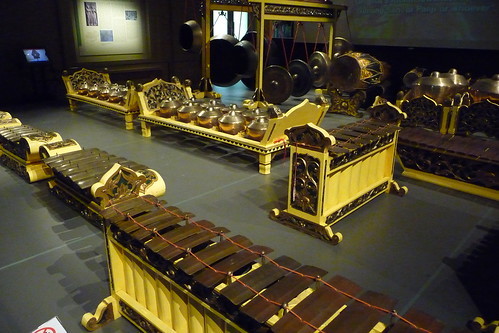
Another thing to take into consideration in a piano is the variety of controls a version has for sound modification. Many piano keyboards come geared up with setups to make the piano seem like different music instruments. Some also have voice setups, so certain keys sound like a choir vocal singing. Once again, if you desire just your typical piano audio, you may not require all these audio controls. To maintain your costs down, it's finest to buy a design with only the features you will make use of. A crucial factor to consider, particularly if you reside in a home or condo, is audio control. You want a keyboard that permits you to set the volume as low as feasible while preserving high quality and also clearness of noise. You also want a keyboard that permits headphone plug-in, so you can play as loud as you require without troubling any individual.
With today's "going environment-friendly" issues, you may intend to explore the energy use of key-boards. Key-boards that are eco-friendly pleasant make certain to be the most recent designs and also can save you dollars on power expenses. Keeping that money, you can update to a higher-priced keyboard later. Additional points to think about are any type of special benefits or perks for acquiring. Some music studios sell keyboards as well as may supply lesson or songs publication price cuts for purchasing from them. Some songs shops use songs lessons on premises as well as may use cost-free initial piano lessons with a keyboard acquisition.
When buying a keyboard is its capacity for add-ons, the final thing to take into consideration. Besides the headphones, you might desire electrical outlets for an amplifier or a Musical Instrument Digital Interface electrical outlet. This allows you to hook a key-board right into a computer. Of course, the computer likewise needs to have a MIDI input. If your computer system doesn't, you need to get a USB MIDI adapter. With the proper software program in place, you can play notes on a keyboard and also have them show up as created songs on your display. The computer plays the notes back, as well as the program stores the played notes on the computer system. Seek a key-board with this electrical outlet if this looks like an appealing alternative. Take the time to investigate all the piano choices offered to you on the marketplace. There are designs as well as makes to match your exact requirements. All you need is an investigatory perspective to seek the one that's right for you.
1 note
·
View note
Video
youtube
Kurzweil M90 ALL SOUNDS demo . Cheapest digital piano from Kurzweil. Do you know any alternative for this price?
1 note
·
View note
Text
Jason Chatfield.
Bio: I grew up in the far flung suburbs of Perth, in Western Australia, and used to spend my paper route money on MAD Magazines (I cheaped-out and stole my dentist’s waiting room issues of the New Yorker. I think I was the only kid who looked forward to going to the dentist).
I moved to New York in 2014 and started pitching to the mag in person. I’m not sure Bob liked me, so I went back to pitching via email. Then I went in on his last day and finally sold my first piece. I feel like it was his final f—k you to the magazine. “Here! Have a Chatfield!”
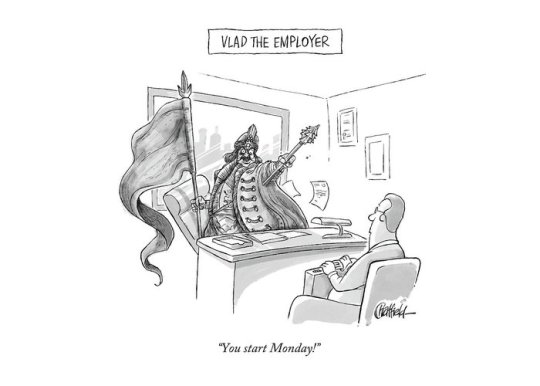
Find this print here!
The cartoon was a goofy play on Vlad the Impaler.
I didn’t sell to the magazine again until last month, but I’ve had a handful sold as dailies. And I’m published in MAD often, so they’ve clearly done away with any of their standards.
When I’m not drawing gag cartoons I write and draw a syndicated legacy strip called Ginger Meggs which I took over 10 years ago. It’s been around since 1921 and now appears daily in 34 countries. He’s kind of an Australian version of Dennis the Menace, except he predates him by about 30 years.
Tools of choice: For drawing/roughs, I use a Prismacolor Turquoise clutch pencil with a red lead and try to find some paper with a little bit of tooth. The mixed media pads at Blick do the trick nicely.

I ink using a Uni-ball Vision Elite Stick Roller Ball Pen… or a Pigma Micron 03.

DO NOT use the Uni-Ball Vision Rollerball Pens, Fine Point (0.7mm) if you’re traveling. They explode on planes. And ruin your copy of The New Yorker.
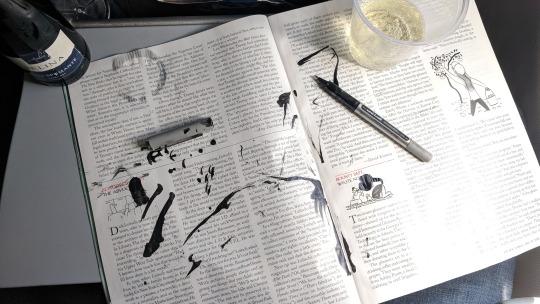
For a wash, I just use watercolor and whatever brush is lying around. Nothing fancy. There’s a scanning app on my phone called “Adobe Scan” which does a nice job of scanning line-art into a PDF when I’m out of the studio and need to email in a quick rough.
I use a Wacom Mobilestudio Pro for finished artwork. I like to get out of the studio and work from a bar or restaurant, so it helps that I can take that with me. I use a little glove that I got on Amazon so I don’t grease up the screen, and the felt-tip nib that comes in the pen-holder makes the friction between the stylus and the screen more like pencil on paper. Unfortunately, they’re not waterproof, as I found on a recent vacation…
youtube
My wife plays piano and sings at bars around the city so I’ll often sit at the bar during her sets and draw. Digital/Traditional depends on what deadlines are most pressing. (She has a weekly residency in Astoria —if anyone’s interested in going, let me know!)
A lot of people email me for advice about tablets —I’ve been trialling/demo-ing Wacom products for 15 years— I think they’re great. If you’re married to doing stuff by hand but want to colour digitally, you can get a decent tablet without going broke. Depends on your workflow.
Writing Desk: My wife and I were living upstairs in 5A when my neighbour in 4B died. He was a brilliant poet and had an incredible old writing desk. It’s the only thing that was left in the apartment, so I’m looking after it ’til his grandson moves in at the end of our lease. I work for countless hours at this old thing. It’s beat up, but I’ve patched it together enough that it won’t collapse and bury me mid-brushstroke. I’ve stuck a few of my favourite toons on the top of it.
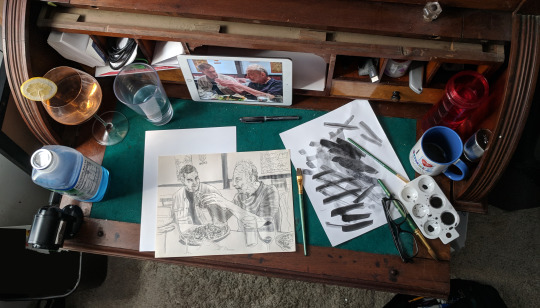
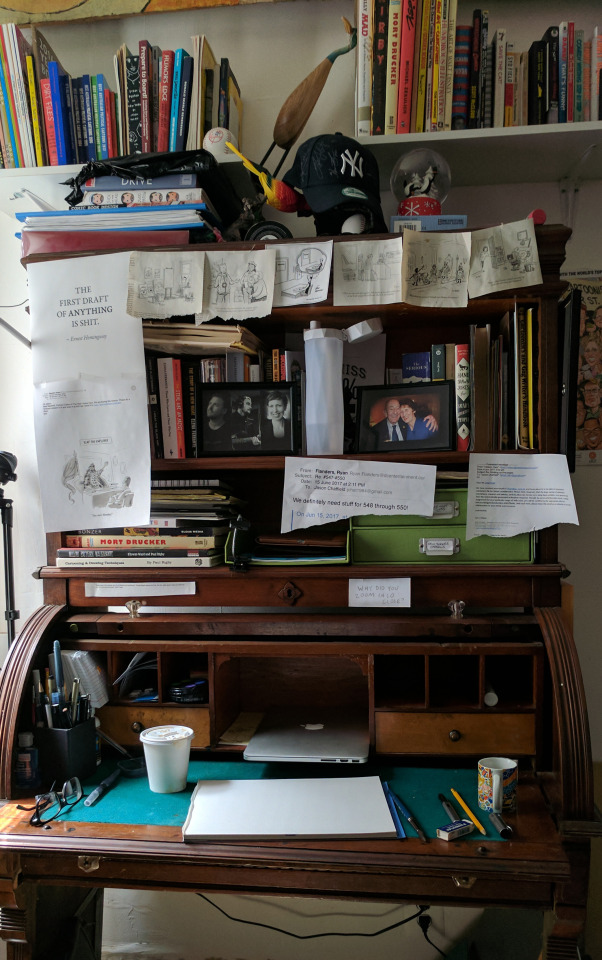
Tool I wish I could use better: My brain. It really is a sack of cats. Whenever I want to sit and do work, it clocks off. Then it comes up with a pearler of an idea at 3 in the morning when I’m trying to sleep. I write it down in my phone, but autocorrect makes it indecipherable by morning.
I like working with my writer friend, Scott. We both do comedy at night and have developed a nice short-hand. We also seem to have the same library of references and can build on each others’ premises, which tames my sack-of-cats.

Tool I wish existed: The Deadline Extender.® I’ve never missed a deadline, but that said… an extra 3 or 4 minutes to allow for a terrible wifi connection, or a errant scanner wouldn’t go astray.
Also: The Deadline Extender® PREMIUM: Let’s you go back in time to when you were procrastinating and slap yourself in the face. $30 p/month.
Tricks: Ok, well. This is going to sound a bit Dalton Trumbo, but bear with me: I do my best work…in the bath.The most productive 3 hours of my week are during Scotchbath Sunday; an immoveable chunk of time on Sunday evening whereby I lock myself in the bathroom, run a bath, lug my drawing stuff onto a bit of wood that sits over the bath, and just write and draw. Nothing else. I write weeks worth of my syndicated comic strip (Ginger Meggs), I write New Yorker cartoons, scribble up roughs for dailies— and when I feel like I’ve earned it (usually 2 hours in) I tap the side of the bath three times, and my wife peels herself from her piano and I unlock the door to a nice big glass of scotch. It’s a hell of a carrot on a stick to work towards when you’re stuck. (PS. Lest you think I’m some kind of Don Draper-era misogynist; the scotch reward part was her idea. I think she realized it keeps me in the bath and out of her way.)
Anyway. It’s a great way to switch gears creatively. It’s like being on an aeroplane. No wifi, no phones — just the work you need to get done. Get involved. #ScotchBathSunday.
Oh! And if I get my deadlines done for the week, I have a small budget for a solo lunch somewhere where I can eat cheese and draw. I really didn’t know cheese ’til I moved to America. (And yes, I’ve already been to Wisconsin. Good Lord.)
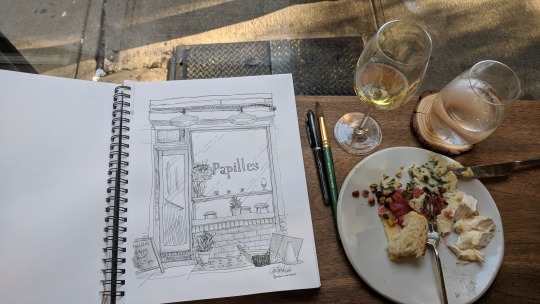
Tips? I always tell younger artists to not even think about touching a drawing tablet until they’ve learned to draw by hand first. Otherwise they’ll always be drawing away, knowing they have the insurance of the CTRL+Z key at their disposal if they screw up a line. That’s not a good habit to have when you’re working to a deadline. But, once you do know how to draw, by all means dive head-first into the digital realm. It’s incredible. Procreate, Sketchbook or Photoshop are all great.
Misc: One of the hangovers from working in advertising illustration is that I’ve had to be a bit of a chameleon style-wise for the last 15 years and haven’t allowed myself to just settle into one style. Lately, I’ve just decided to say “Bugger it!” and try and find a loose, consistent style that I’m comfortable with, that’s an apt conduit to my silly ideas.
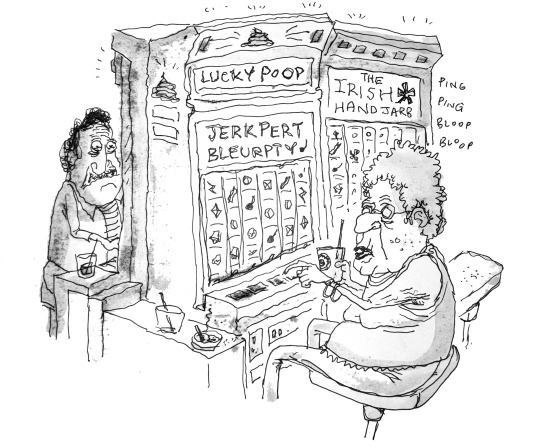
I always loved George Booth’s line, and his ability to create a scene with so much movement but just at the right moment in time. Also Sam Gross’ dark, hilarious cartoons with perfect line-economy. And I’d give my left arm (I draw with my right) to know how Barry Blitt has so much control with his washes…
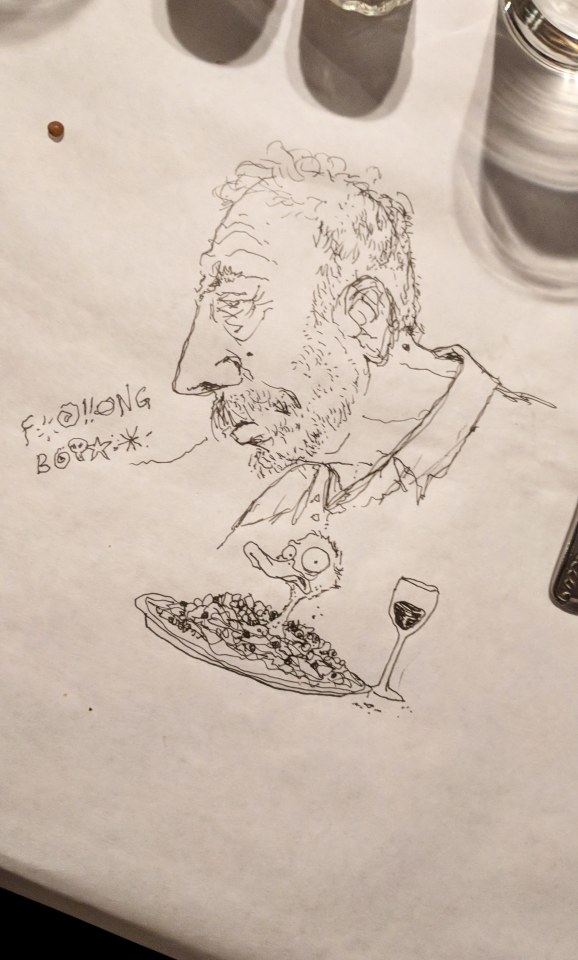
Chatfield’s portrait of Sam Gross
While I’m geeking out, I love seeing younger cartoonists find their feet and thrive in a style that just feels like they’re speaking to you— Ellis J. Rosen, Sofia Warren, Hilary Fitzgerald Campbell, Jason Katzenstein, Amy Kurzweil, and a seemingly endless list of talented younger artists who are putting in the work are a big inspiration.

I know it should be Steig or Thurber or Addams, but my favourite cartoonist is Sergio Aragones.
I was always so enamoured of MAD growing up and studied the lines of Jack Davis, Mort Drucker, Al Jaffee and the Usual Gang of Idiots. I remember being so frustrated I couldn’t even come close to getting my work to look like theirs, but I think I found a style somewhere in between when I fell short.
I think Wil McPhail’s poses are masterful, and I wish I knew how how the hell he did that. One day I’ll trudge up to England and knock on his door to ask him. I find myself doubled-over at John Cuneo’s Instagram, and Ed Steed’s absurdly funny gags. I have a slew of toons I’ve torn out of years’ worth of magazines and taped to my studio wall, or my zillion year-old writing desk. I’m constantly humbled by how generous and welcoming the existing crop of New Yorker cartoonists have been to a goofy Aussie immigrant — Joe Dator, Matt Diffee and Pat Byrnes, Mort Gerberg and an ever-growing list of prolific, talented cartoonists who make the 99% weekly rejection tolerable.
I’ve made some of my closest friends and have been lucky enough to meet my cartooning heroes through the National Cartoonists Society. I got to spend a lot of time with Sergio at the Lakes International Comic Art Festival in the UK last year which made my year. We were signing together for a whole afternoon and I spent more time geeking out with him than signing.
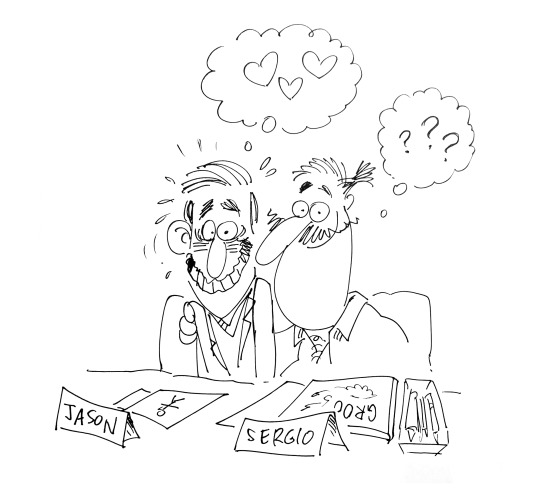
Okay. Enough drooling. Sorry.
I’m a fan of cartoonists.
Website, etc.
I have a weekly podcast where I throw around ideas for New Yorker cartoons with a fellow comedian and writer, Scott Dooley. It’s called “Is There Something In This?” It’s a bit of fun. We don’t take ourselves too seriously, but we do take the art of writing gags very seriously. It’s an extremely difficult skill to master, and we’re virtually zygotes at it. We have lots of listeners now, which is bewildering. Talking about drawing is like dancing about architecture, but here we are. Anyway you can find it on iTunes or wherever you waste time listening to podcasts.
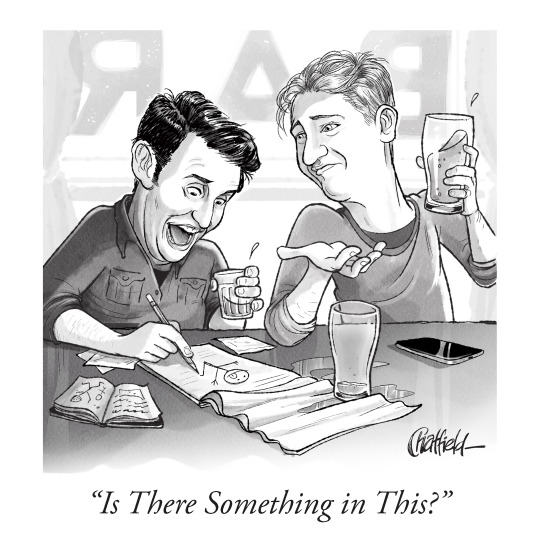
My website is jasonchatfield.com and my comedy stuff is up at jasonchatfieldcomedy.com ( I’ve been doing stand-up comedy for 11 years. If anyone wants to come see a show, hit me up! I’ll put you on the door).
My instagram is @jasonchatfield. I’m still trolling the British chap who has the @jasonchatfield handle on Twitter to no avail. To that end, I’m @jason_chatfield on Twitter.
If you want more art supplies in your life, A Case for Pencils is on Instagram and Twitter. You can also find me, Jane (the person who created/edits this blog), on Twitter here, which is where I stick the paintings that I’ve been doing instead of interviewing people consistently (I needed to balance working on other people’s work and my own work!). Oh, and If you’d like to support this blog, which is always very appreciated, there are many different ways to do so, which you can find here!
#Jason chatfield#how to draw New Yorker cartoons#artists on tumblr#art supplies#drawing process#artist interview
18 notes
·
View notes
Photo

A fun (or funny translation, thanks Google) article from a German paper on Rick’s death. (Link to the original article at the end for any German speaking readers.) Enjoy!
17th May 2010, 9:48 pm
To the death of Richard Wright
The soul of the monster
Goodbye, Mr. Chance: The death of frighteningly likable keyboarder Richard Wright on Monday broke the heart of Pink Floyd.
By Alexander Gorkow
That a band is only as big as the sum of its components, can also be expressed rude. After leaving the monster Pink Floyd in 1984 and wondering about half-empty halls on his first solo tour, Roger Waters told him, "You think you're the monster you created, Roger, but the monster is now larger than you."

The soul of the monster: Pink Floyd keyboarder Richard Wright was above all very British. (Photo: Photo: AP)
The dinosaur Pink Floyd - whom you will never see and hear on a stage since the death of keyboardist Richard Wright on Monday in London - was above all: very British in his elegant rage and sneer. Wright's penchant for jazz and the great classical composers continued to enrich the band's extensive blues rock with delicate and somehow Victorian-looking colors.
It was Wright's harmonies on the Hammond organ, the mini-moog, later on the digital Kurzweil synthesizer and, most beautifully, on the grand piano, the genetic code of Pink Floyd's music, and maybe that gorgeous monster-in-itself accounted for.
Such an alluring mix of violence, humility and sarcasm has not gotten the epigones off the hook, Radiohead appears to be whiny, Coldplay far too stupid, many too aimless. Rumors that the band will in the original cast of the post-Syd-Barrett phase actually give some concerts for eternity, therefore recently made for a certain super excitement in the starving music industry. It's ironically ironic that the question of how Roger Waters and David Gilmour get along with each other since Monday - because now the class stalemate has just taken off.
Like a world-weary professor of literature
Nowadays songs are mostly written by Linda Perry, produced by Timbaland and then burped on computers like horror stations like Bayern 3. It is no longer easy to see that it was the sum of a group of band members who outdid themselves with great patience before imploding into hubris.
Similar to the Beatles, Pink Floyd had a congenial team split: the nervous Waters loaded music and lyrics with the aggressive self-pity that great songs need; second singer and guitarist David Gilmour provided sexual tension with a warm voice and crashing Fender runs; drummer and humorist Nick Mason's secondary occupation included everyday sounds in the head cinema, fighter jets, cash registers, not least the heartbeat that initiates an indestructible epic of younger existentialism, such as the bitter-comic "Dark Side Of The Moon".
Richard Wright, a man of almost explosive shyness, he was what George Harrison was to the Beatles: not head, not hip - but the soul of this monster, a downright frighteningly likable man of fragile build, still a keyboarder on the last Gilmour's solo tour in 2006, was as ethereally in the dressing room as a professor of literature who had erred in the house number.
If you talked to him, you initially had the impression that he is only there to take a look at everything backstage. Nevertheless, Wright always surrounded the world of a Peter Sellers, and not least in his last years he reminded of the tragicomic Mr.Chance from Sellers' last film, who believes in the street outside, he could fend off attackers with the TV remote control.
Sometimes megalomaniac
Wright also needed humor to survive (albeit mentally injured) in the massacre committed by the alpha animals Waters and Gilmour: he once gave the songs to the secret ballot among the band members for the song selection of a best-of record The other band members each zero points, but his own ten, a rebellious and funny trick, but the auffllog!
Like Roger Waters and Nick Mason, Wright first studied architecture at London's Regent Street Polytechnic in the early 1960s, which sounds like Pink Floyd's spatial, sometimes megalomaniacal music. When Waters borrowed a cigarette from Wright in the spring of 1963 and damaged the pack, there was a dispute for the first time - according to Mason the big bang for countless communication problems that kept up to the recent past, the most backward London lawyers on the go.
No one suffered as badly as Wright, who was kicked out of Waters after the 1980 "The Wall" record for indecent behavior and given a stinking rental music contract.
In songs like "Wearing the Inside Out," Wright later went into severe depression, and since he was too defensive to sell CDs, Gilmour's power plug took on his friend. On their last and most successful tour, the two played a sparkling version of underwater performer "Echoes". No one will be able to do this any more than the night of July 2, 2005 in London, when Waters and Gilmour decided to end a truce for four songs at the Live 8 concert after 25 years of strife. For the last time, the heartbeat of the Dark Side thundered over half a million heads in Hyde Park, and even graying punks were crying like babies.
The heart of Pink Floyd stopped beating on Monday. The last word on the main record in 1972 was the jolly janitor of the Abbey Road Studios: "There is no dark side of the moon - it is dark everywhere."
Richard Wright died of cancer. He was 65 years old.
https://www.sueddeutsche.de/kultur/zum-tod-von-richard-wright-die-seele-des-monsters-1.694014
14 notes
·
View notes
Photo

$168.81 Only! ~ Kurzweil SCSI Hard Drive Emulator,8GB memory card,Samples/Programs,cables,extras, Digital Piano Keyboard, Best Electronic Keyboards BUY HERE! #DigitalPianoKeyboard, #BestElectronicKeyboards,
0 notes
Link
0 notes
Text
Global Digital Piano Market 2020 : Investment Feasibility Analysis, Key Factors, New Entrants SWOT Analysis and Forecast 2025
The report firstly introduced the Digital Piano market System basics: definitions, classifications, applications and market overview; product specifications; manufacturing processes; cost structures, raw materials and so on. At that point it broke down the world's primary locale economic situations, including the item value, benefit, limit, supply, request and market development rate and estimate and so forth. At last, the report presented new venture SWOT examination, speculation plausibility investigation, and venture return examination.
Request For Sample: Get Free Sample PDF:https://marketstream.biz/report/digital-piano/3363#requestforsample
Keyplayers are:
Williams, Yamaha, Long Beach Music, Hamzer, The ONE Music Group, Casio, TMS, Roland, Privia, Kurzweil, Korg, PianoMaestro, Artesia
This report offers access to huge information, for example,
Current Market Trends
Similar Test Analysis
Market Growth Drivers
Threats in the Digital Piano Market
Market Forecasting for the Coming Years
Segmented By type
49 Key , 54 Key , 61 Key , 73 Key , 76 Key , 88 Key
Segmented By Application
Household , Stage , Others
The report includes six parts, dealing with:
1.) Basic information;
2.) The Asia Digital Piano Market;
3.) The North American Digital Piano Market;
4.) The European Digital Piano Market;
5.) Market entry and investment feasibility;
6.) The report conclusion.
Inquiry Here For More Details or For Customized/Customization Report https://marketstream.biz/report/digital-piano/3363#inquiry
Key Points Covered in TOC:
Firstly, the report covers the top Digital Piano manufacturing industry players from regions like United States, EU, Japan, and China. It also characterizes the market based on geological regions.
Further, the Digital Piano report gives information on the company profile, market share and contact details along with value chain analysis of Digital Piano industry, Digital Piano industry rules and policies, circumstances driving the growth of the market and compulsion blocking the growth. Digital Piano Market development scope and various business strategies are also mentioned in this report.
The Digital Piano research report includes the products that are currently in demand and available in the market along with their cost breakup, manufacturing volume, import/export scheme and contribution to the Digital Piano market revenue worldwide.
Finally, Digital Piano market report gives you details about the market research findings and conclusion which helps you to develop profitable market strategies to gain competitive advantage.
Browse Detail TOC with Tables, Table Of Figure, Pie Charts etc: https://marketstream.biz/report/digital-piano/3363#toc
0 notes
Text
Global Digital Piano Market
The report forecast global Digital Piano market to grow to reach xxx Million USD in 2019 with a CAGR of xx% during the period 2020-2025 due to coronavirus situation.
The report offers detailed coverage of Digital Piano industry and main market trends with impact of coronavirus. The market research includes historical and forecast market data, demand, application details, price trends, and company shares of the leading Digital Piano by geography. The report splits the market size, by volume and value, on the basis of application type and geography.
First, this report covers the present status and the future prospects of the global Digital Piano market for 2015-2024.
And in this report, we analyze global market from 5 geographies: Asia-Pacific[China, Southeast Asia, India, Japan, Korea, Western Asia], Europe[Germany, UK, France, Italy, Russia, Spain, Netherlands, Turkey, Switzerland], North America[United States, Canada, Mexico], Middle East & Africa[GCC, North Africa, South Africa], South America[Brazil, Argentina, Columbia, Chile, Peru].
At the same time, we classify Digital Piano according to the type, application by geography. More importantly, the report includes major countries market based on the type and application.
Finally, the report provides detailed profile and data information analysis of leading Digital Piano company.
Key Content of Chapters as follows (Including and can be customized) :
Part 1:
Market Overview, Development, and Segment by Type, Application & Region
Part 2:
Company information, Sales, Cost, Margin etc.
Part 3:
Global Market by company, Type, Application & Geography
Part 4:
Asia-Pacific Market by Type, Application & Geography
Part 5:
Europe Market by Type, Application & Geography
Part 6:
North America Market by Type, Application & Geography
Part 7:
South America Market by Type, Application & Geography
Part 8:
Middle East & Africa Market by Type, Application & Geography
Part 9:
Market Features
Part 10:
Investment Opportunity
Part 11:
Conclusion
Market Segment as follows:
By Region
Asia-Pacific[China, Southeast Asia, India, Japan, Korea, Western Asia]
Europe[Germany, UK, France, Italy, Russia, Spain, Netherlands, Turkey, Switzerland]
North America[United States, Canada, Mexico]
Middle East & Africa[GCC, North Africa, South Africa]
South America[Brazil, Argentina, Columbia, Chile, Peru]
Key Companies
Williams
Yamaha
Long Beach Music
Hamzer
The ONE Music Group
Casio
TMS
Roland
Privia
Kurzweil
Korg
PianoMaestro
Artesia
Market by Type
49 Key
54 Key
61 Key
73 Key
76 Key
88 Key
Market by Application
Household
Stage
Others
For sample report please visit: https://www.statzyreports.com/report.php?reportname=SR158561
Phone Number
(IN) - +918484035727
(US) - +1415-871-0483
Email Address
Email : [email protected]
Email : [email protected]
0 notes
Photo

This beautiful MPS-120 digital piano was sent to me out of the blue by @kurzweilmusic - thanks so much, you guys! I love the wooden key action, Thelonious Rex Nash-Malone Kittenhead prefers the box.🎹 . . . #kurzweil #kurzweilmps120 #woodenkeyaction #piano #endorsement #gingercatsofinstagram #gingercat #orangetabby #redtabby #bobmalone (at Studio City, California) https://www.instagram.com/p/B96Ndq9gVJw/?igshid=1pt8r3wj9pdpq
#kurzweil#kurzweilmps120#woodenkeyaction#piano#endorsement#gingercatsofinstagram#gingercat#orangetabby#redtabby#bobmalone
0 notes
Text
I feel people are underreacting to OpenAI's Jukebox. This neural network is generating waveforms themselves!
The technology in question and one of the more famous outputs.
The best part is that it's synthesizing the songs via waveform generation.
Traditional synthetic music would typically do it by splicing together different notes (and thus humans would actually play the music), through MIDI files, or by playing digital instruments (like synth guitars and drums in FL Studios). We've been doing this for decades.
Anyone who used the internet or played video games in the 90s and 2000s remembers MIDI files being everywhere because they were easy to make and easy on memory, so it stands to no one's surprise that they've often been used by AI researchers to get various AI techniques (not just neural networks either, especially not before the 2010s) to generate music using them. And Ray Kurzweil himself literally pulled off the first in 1965.
AI composing music has been around for a long time indeed, and even generating itself has been possible for a good long while. Since before I was born, at least. But never like this.
This does it another way entirely: it creates music by literally generating the audio waveforms, which is insane. When I was a bit younger, I figured that an AI could potentially do this— I knew that my own voice was just a waveform and editing that waveform could turn it into anything. I remember opening up Audacity files of various tracks that had audio glitches that I couldn't remove without messing with the music or voices, wishing there was some way to play with those waveforms. I'd zoom in as close as I could until the waveform was just a slightly curved line, play with a tiny bit of that line, and marvel at how totally that changed what that segment sounded like. This resulted in me imagining what it'd be like to have an AI be able to understand audio waveforms well enough to intelligently manipulate them to the extent that it could generate novel music, voices, and sounds. I knew it was possible. But I didn't think we'd pull it off by 2020.
To use an analogy, you know of lab-grown/in vitro meat? It's one of several different types of alternative meat, the most famous being meatless vegan meat (which isn't half bad). However, meatless meat is made from plants and treated to have the taste and consistency of meat. They're not meat at all. No fibers, no muscles, no fat; nothing.
In vitro meat is meat. It's grown through different methods, but it still grows as meat cells— muscles, tendons, fat, maybe even bones eventually. Just without the animal attached. Both synthetic, but one is actually what it's pretending to be.
That's this in a nutshell.
When you hear a guitar in a Jukebox-generated song, you're actually hearing a guitar, even though no physical guitar was ever played. It's not a MIDI file of a guitar, nor is it a prerecording or rough synthetic version. We're hearing the raw audio of a guitar.
This is because the neural network is essentially "imagining" what a guitar sounds like. I use that word loosely, of course. But you do it similarly in your head. You've heard what a guitar sounds like, likely in many different ways. And if I asked you to imagine the guitar-driven part of, say, "Bohemian Rhapsody," you could probably do it easily. Same deal with the piano parts. And you're probably remember the drums, bass, and vocals without even being prompted.
And if I asked you to imagine Freddy Mercury sing the entire song in falsetto or for the band to rerecord the song but turn the piano sections into future-funk but left the heavy rock parts intact (or perhaps even vice versa), you could probably imagine it easily as well.
That's what Jukebox is doing.
I already knew neural networks could do this— WaveNet showed off this capability back in 2016, using its audio waveform generation to synthesize voices and piano. I was simply waiting for the day this was combined and translated into full musical pieces. And now it's here.
Almost.
The Jukebox tracks were apparently hell to render, taking hours just to make a single minute. But it won't be long before we have the ability to generate any sort of song— including mash-ups, hybrids, remixes, and remakes in any style.
My long dream of an AI-generated barbershop quartet cover of TLC's Waterfalls & a female-fronted Witchfinder General is taking shape.
But that's just the present.
This is clearly just in its infancy, to the point that it suffers from the "S-curve effect"— older methods, including MIDI generation (think of MuseNet, also from OpenAI) obviously sound better than this because they have so much refinement, whereas Jukebox's songs all occupy the auditory uncanny valley, as if we're picking up songs from an alternate universe through a shortwave radio. Furthermore, these tracks only resemble their parents songs on the surface— dig any deeper, and you'd realize that the AI doesn't seem to know how to pull off a verse-chorus-verse or loop verses (so it'd make for good art punk probably). As admirable as it is, it still leaves a lot to be desired.
But these will all be solved with just a little bit more compute and work. Indeed, by the end of this year, it might be exponentially better than it already is. And within five years, we'd have a "music generator" that could easily handle any request.
Actually, not just music generator. ANY sound could be generated. It's all audio waveforms, after all.
TLDR, OpenAI stuns us once again by unveiling the first generation of an AI that can generate any sound by directly generating raw audio waveforms rather than making a MIDI file or composing notes for humans to play
This means we can hear a computer generate music electronic music... I know that sounds redundant, but I mean that this would basically synthesize the sound of synthesizers rather than playing those synthesizers itself. It's double-layered synths...
submitted by /u/Yuli-Ban
[link] [comments]
source https://www.reddit.com/r/Futurology/comments/gi42b9/i_feel_people_are_underreacting_to_openais/
0 notes
Photo


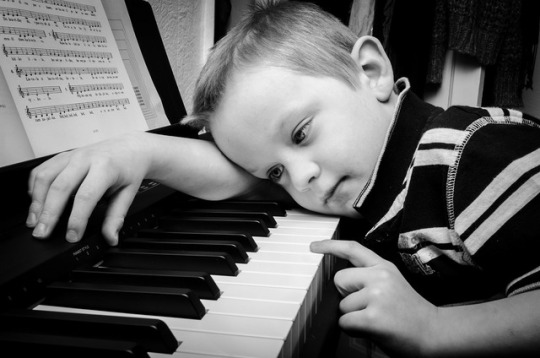
We’re passionate about all things musical and love sharing my experiences and stories with people. Music is truly the universal language!
We've sourced some great quality products with fantastic brand names such as Broadway, Kurzweil and Gewa.
We'll be posting up my latest news and stories and hopefully we can share our love of music together.
'When words fail, music speaks'
We at SOUND BUDDY are passionate about providing the best value and quality products for you to speak through your music. From grand pianos to digital keyboards, headphones to piano stools – it's all about the music!
0 notes